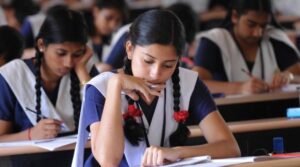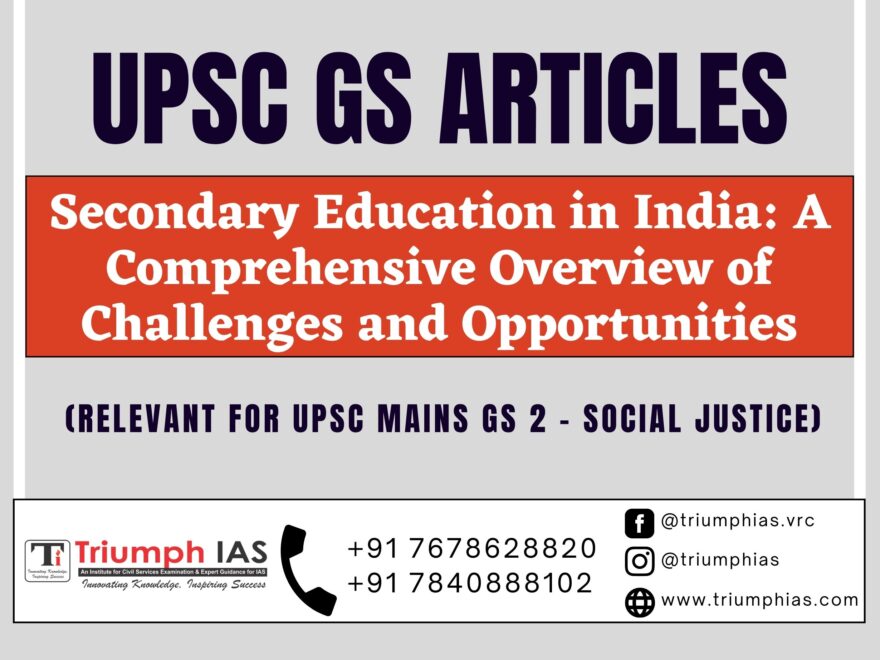Secondary Education in India: A Comprehensive Overview of Challenges and Opportunities
Relevant for UPSC Mains GS 2 – Social Justice

Introduction: India’s education system is vast and diverse, playing a critical role in the country’s development and progress. Secondary education, in particular, is a crucial phase in a student’s academic journey, as it prepares them for higher education and the world of work. In this extensive blog, we will explore secondary education in India, examine the challenges it faces, and discuss the prospects for improvement and growth.
- Secondary Education in India: An Overview.
Secondary education in India refers to the education provided to students between the ages of 14 and 18, following the completion of primary education. According to the National Education Policy (NEP) 2020, secondary education is divided into two stages: the middle stage (ages 11-14) and the secondary stage (ages 14-18). Secondary education in India is governed by both the central and state governments, with states having the autonomy to frame their respective policies and curricula.
Secondary education typically culminates in the awarding of a certificate, such as the Secondary School Certificate (SSC) or the Indian Certificate of Secondary Education (ICSE), upon successful completion of the curriculum and examinations.
- Challenges Facing Secondary Education in India.
The secondary education sector in India faces several challenges that hinder its progress and impact the quality of education provided to students. Some of the key challenges include:
- Access to Secondary Education: Although the Right to Education (RTE) Act has improved access to primary education, access to secondary education remains a challenge for many students, particularly those in rural and remote areas.
Possible Solutions:
- Expanding infrastructure: Building more secondary schools, especially in rural and remote regions, can help improve access to secondary education.
- Strengthening the transition from primary to secondary education: Implementing policies and programs that support students in their transition from primary to secondary education can help reduce dropout rates and ensure greater access to secondary education.
- Quality of Education: The quality of education provided in secondary schools varies greatly across the country, with factors such as outdated teaching methods, lack of resources, and inadequate teacher training contributing to the issue.
Possible Solutions:
- Teacher training and development: Providing adequate training and professional development opportunities for teachers can help improve the quality of education in secondary schools.
- Curriculum reform: Updating the curriculum to make it more relevant, engaging, and student-centric can enhance learning outcomes and better prepare students for higher education and the workforce.
- High Dropout Rates: Many students drop out of secondary education due to various factors, including poverty, child labour, early marriage, and inadequate infrastructure.
Possible Solutions:
- Addressing socio-economic issues: Implementing policies and programs that tackle poverty, child labor, and early marriage can help reduce dropout rates in secondary education.
- Retention initiatives: Introducing scholarships, mid-day meal schemes, and other incentives can encourage students to continue their education beyond the primary level.
- Teacher Shortages: India faces a significant shortage of qualified and trained teachers, particularly in rural areas. Overburdened teachers often struggle to provide individual attention to students, impacting the quality of education.
Possible Solutions:
- Recruitment initiatives: Attracting qualified individuals to the teaching profession through competitive compensation packages and other incentives can help address the shortage of teachers.
- Enhancing teacher training programs: Strengthening pre-service and in-service teacher training programs can ensure that teachers are equipped with the necessary skills and knowledge to provide quality education.
- Inequality in Education
Socio-economic disparities, gender biases, and discrimination against marginalized communities often hinder access to quality secondary education for all.
Possible Solutions:
- Promoting inclusive education: Implementing policies and programs that promote inclusive education, such as scholarships for marginalized students, gender-sensitive curricula, and accessible infrastructure for students with disabilities, can help bridge the inequality gap in secondary education.
- Prospects for Improving Secondary Education in India.
Despite the challenges, there are several promising developments and initiatives aimed at improving secondary education in India:
- National Education Policy (NEP) 2020: The NEP 2020 aims to revamp the entire education system in India, with a focus on secondary education. Some key initiatives include the introduction of a new curriculum framework, emphasis on skill development, and provisions for the professional development of teachers.
- Use of Technology: The integration of technology in secondary education can help address issues related to access and quality. Initiatives such as e-learning platforms, digital libraries, and online teacher training programs are being implemented to bridge the gap between urban and rural schools.
- Public-Private Partnerships (PPPs): PPPs can play a vital role in improving secondary education in India. Private players can contribute by providing resources, expertise, and innovative teaching methodologies. Successful examples of PPPs in secondary education include the Akanksha Foundation, Teach for India, and the Central Square Foundation, among others.
- Community Involvement: Engaging local communities in the management and decision-making processes of secondary schools can help address issues of access, quality, and infrastructure. Community participation can create a sense of ownership and accountability, leading to more sustainable outcomes for secondary education.
Focus on Inclusive Education: Policies and programs aimed at promoting inclusive education can help bridge the inequality gap in secondary education. Students from disadvantaged backgrounds may struggle to keep up with their peers, further exacerbating the inequality gap.

